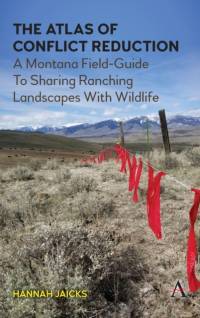Om The Atlas of Conflict Reduction
The book is a firsthand account of Dr. Hannah Jaicks' journey through western Montana's ranching landscapes to showcase the stories of ranchers and affiliated groups who are pioneering strategies for reducing conflicts with wildlife, while also stewarding the landscape. Americans depend on these people who live by working on the land. Ranchers have the power to shape the future of our lands, waterways, and wildlife communities, but enduring perceptions frame ranching as a unilaterally destructive force to the environment. Perception is slippery ground to base an argument on, however, and reality is far more complicated. Often seen as antithetical to one another, American ranchers and wildlife have long been entangled with another. The book is about producers and partner organizations who are forging new paths in conservation and addressing these seemingly intractable entanglements to sustain working ranch operations alongside healthy wildlife populations. It elevates the voices of these people striving daily to achieve wild and working landscapes in the West and serves as a model for how others can begin to do the same. The author takes readers on a journey up western Montana to a different valley in each chapter and showcases the place-based stories of everyday conservation heroes who practice regenerative ranching, provide consciously raised agricultural products, advance strategies for collaborative conservation and protect vital habitat for endemic wildlife that would otherwise be developed and subdivided beyond repair. Ethnographic storytelling is interwoven with psychological theories to inform readers about progressive ways to make the world we share - with people and animals - a better place to live. Illustrations by Katie Christiansen of wildlife and conflict-reduction tools accompany the text, helping to underscore the vivid realities of shared landscapes and how they are achieved. There is no doubt the history of ranching is laden with problematic examples, and public and private rangelands are not universally in good condition today. This book aims to capture the increasing recognition that strong ranching practices coincide with good land and wildlife stewardship measures, but ranchers need help. If we want to see more of this remarkable work happening, environmentalists and concerned citizens need to step up and ensure these practices are not only possible but also become the norm. Everyone must be willing to come to the table and navigate discussions about how to work together more effectively and collaboratively. This book is a roadmap for how people can begin to do so.
Visa mer

